MGT 6202 Business Research: House Buying Behavior in Malaysia
VerifiedAdded on 2023/01/16
|36
|6883
|105
Report
AI Summary
This report presents an investigation into house buying behavior in Malaysia, focusing on consumer behavior within the housing market. The study explores the significance of housing in Malaysia, considering its role in poverty reduction and economic status. The research delves into various factors influencing house purchasing decisions, including price, self-concept, reference groups, and location, drawing upon relevant theories such as the Motivation Theory, Theory of Reasoned Action, and the EKB Model. The methodology includes a descriptive research design with both qualitative and quantitative data collection methods, utilizing semi-structured questionnaires. The report addresses the study's limitations, ethical considerations, and provides a detailed literature review covering Malaysian housing, purchasing models, and consumer behavior. The findings aim to offer insights for both the government and private developers to improve housing construction and cater to consumer preferences, contributing to a better understanding of the Malaysian housing market and its consumers.
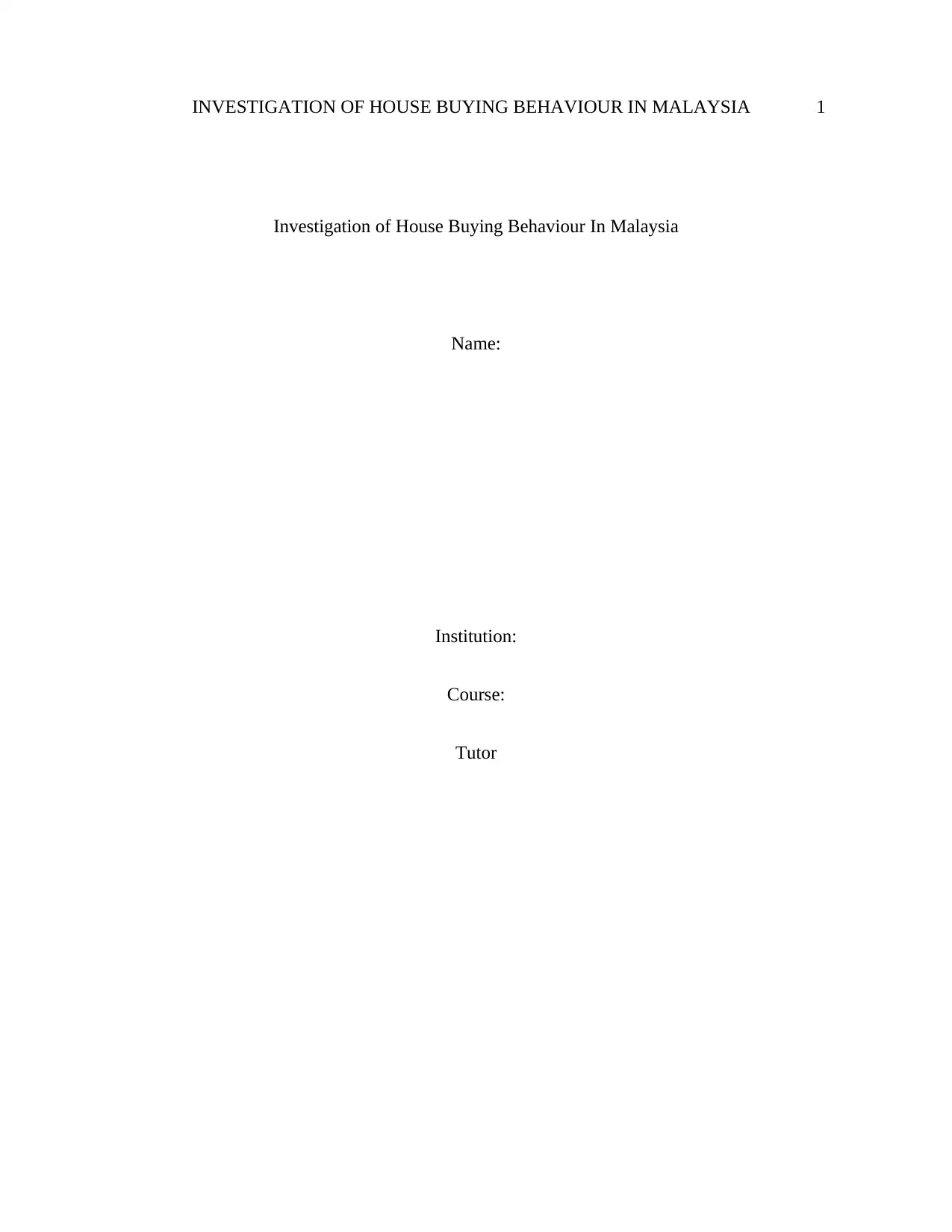
INVESTIGATION OF HOUSE BUYING BEHAVIOUR IN MALAYSIA 1
Investigation of House Buying Behaviour In Malaysia
Name:
Institution:
Course:
Tutor
Investigation of House Buying Behaviour In Malaysia
Name:
Institution:
Course:
Tutor
Paraphrase This Document
Need a fresh take? Get an instant paraphrase of this document with our AI Paraphraser
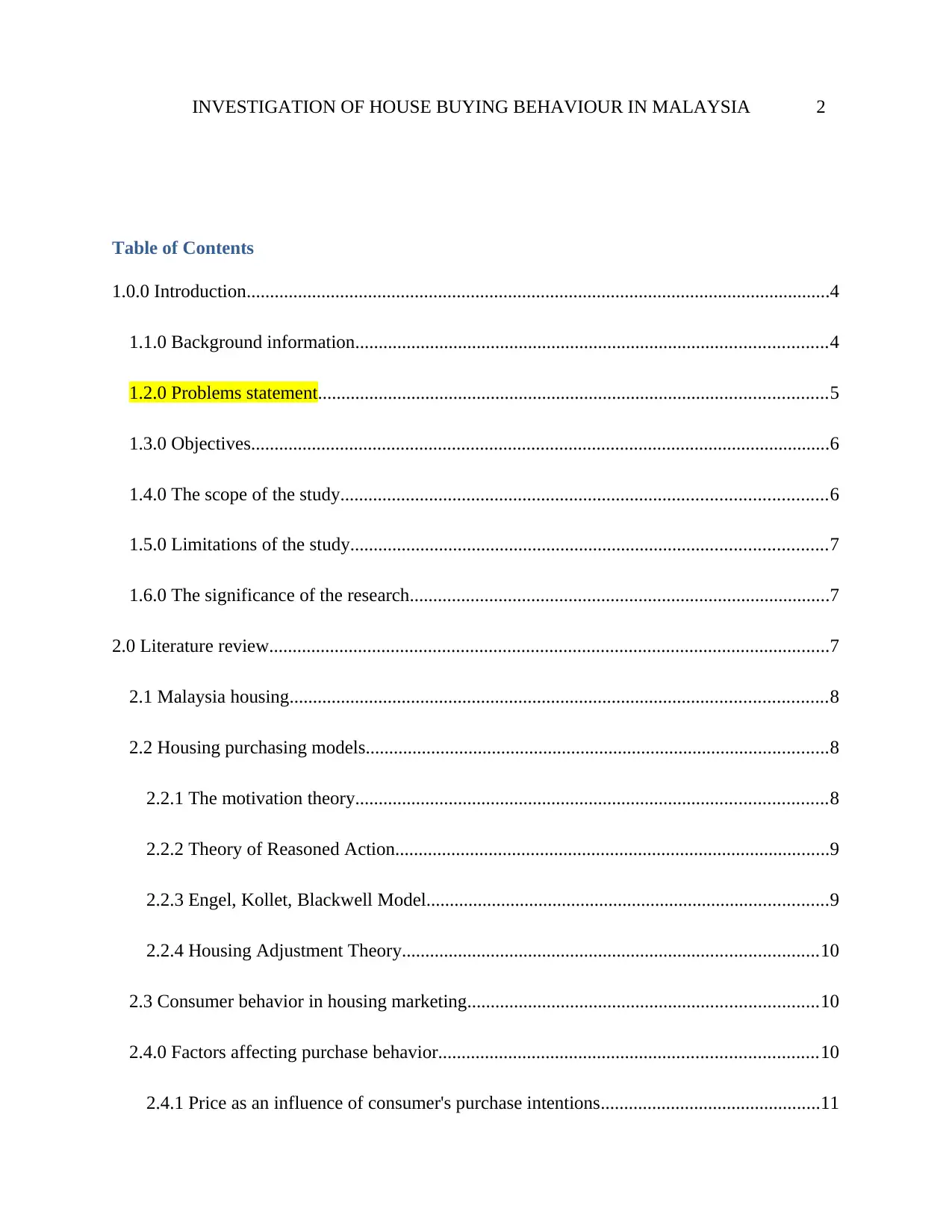
INVESTIGATION OF HOUSE BUYING BEHAVIOUR IN MALAYSIA 2
Table of Contents
1.0.0 Introduction.............................................................................................................................4
1.1.0 Background information.....................................................................................................4
1.2.0 Problems statement.............................................................................................................5
1.3.0 Objectives............................................................................................................................6
1.4.0 The scope of the study........................................................................................................6
1.5.0 Limitations of the study......................................................................................................7
1.6.0 The significance of the research..........................................................................................7
2.0 Literature review........................................................................................................................7
2.1 Malaysia housing...................................................................................................................8
2.2 Housing purchasing models...................................................................................................8
2.2.1 The motivation theory.....................................................................................................8
2.2.2 Theory of Reasoned Action.............................................................................................9
2.2.3 Engel, Kollet, Blackwell Model......................................................................................9
2.2.4 Housing Adjustment Theory.........................................................................................10
2.3 Consumer behavior in housing marketing...........................................................................10
2.4.0 Factors affecting purchase behavior.................................................................................10
2.4.1 Price as an influence of consumer's purchase intentions...............................................11
Table of Contents
1.0.0 Introduction.............................................................................................................................4
1.1.0 Background information.....................................................................................................4
1.2.0 Problems statement.............................................................................................................5
1.3.0 Objectives............................................................................................................................6
1.4.0 The scope of the study........................................................................................................6
1.5.0 Limitations of the study......................................................................................................7
1.6.0 The significance of the research..........................................................................................7
2.0 Literature review........................................................................................................................7
2.1 Malaysia housing...................................................................................................................8
2.2 Housing purchasing models...................................................................................................8
2.2.1 The motivation theory.....................................................................................................8
2.2.2 Theory of Reasoned Action.............................................................................................9
2.2.3 Engel, Kollet, Blackwell Model......................................................................................9
2.2.4 Housing Adjustment Theory.........................................................................................10
2.3 Consumer behavior in housing marketing...........................................................................10
2.4.0 Factors affecting purchase behavior.................................................................................10
2.4.1 Price as an influence of consumer's purchase intentions...............................................11
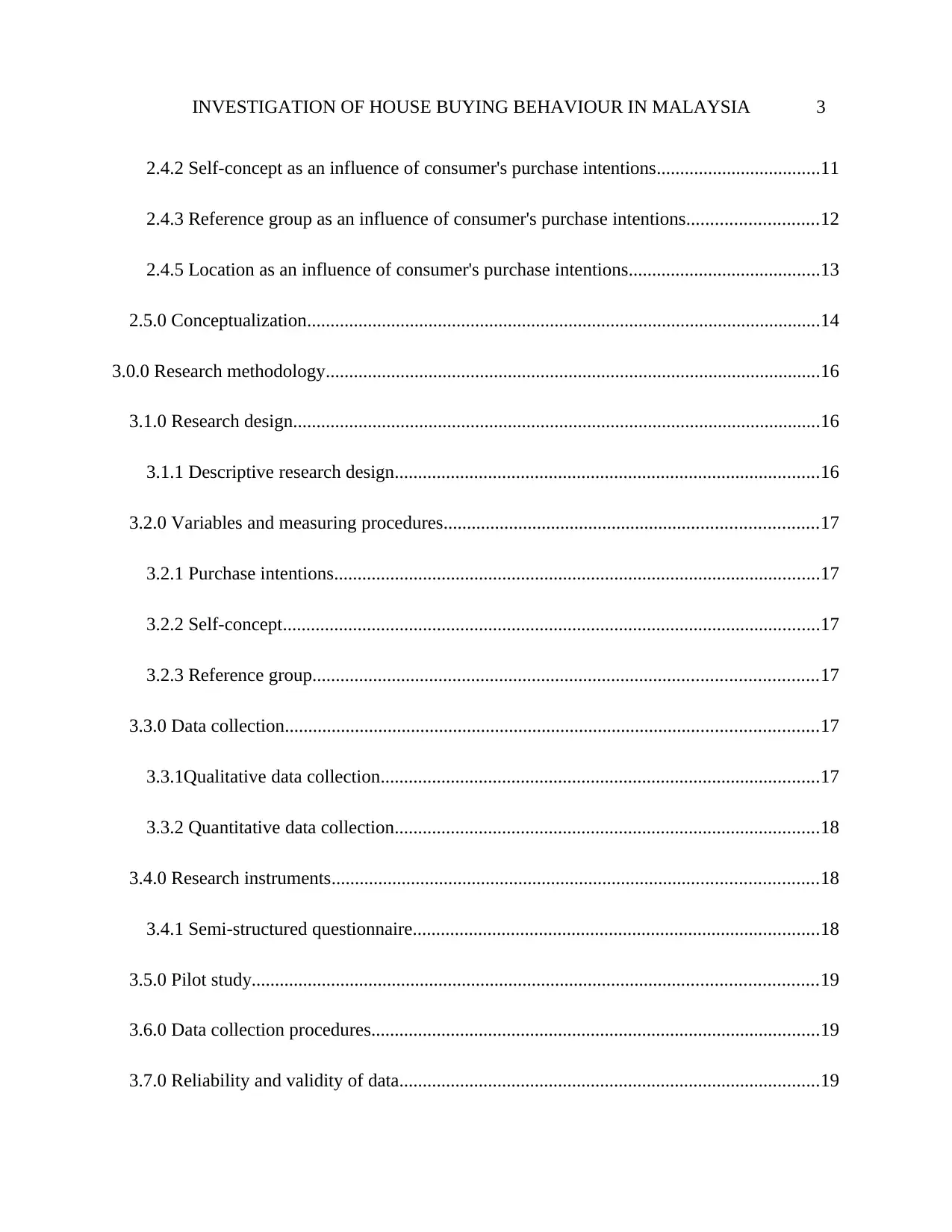
INVESTIGATION OF HOUSE BUYING BEHAVIOUR IN MALAYSIA 3
2.4.2 Self-concept as an influence of consumer's purchase intentions...................................11
2.4.3 Reference group as an influence of consumer's purchase intentions............................12
2.4.5 Location as an influence of consumer's purchase intentions.........................................13
2.5.0 Conceptualization..............................................................................................................14
3.0.0 Research methodology..........................................................................................................16
3.1.0 Research design.................................................................................................................16
3.1.1 Descriptive research design...........................................................................................16
3.2.0 Variables and measuring procedures................................................................................17
3.2.1 Purchase intentions........................................................................................................17
3.2.2 Self-concept...................................................................................................................17
3.2.3 Reference group............................................................................................................17
3.3.0 Data collection..................................................................................................................17
3.3.1Qualitative data collection..............................................................................................17
3.3.2 Quantitative data collection...........................................................................................18
3.4.0 Research instruments........................................................................................................18
3.4.1 Semi-structured questionnaire.......................................................................................18
3.5.0 Pilot study.........................................................................................................................19
3.6.0 Data collection procedures................................................................................................19
3.7.0 Reliability and validity of data..........................................................................................19
2.4.2 Self-concept as an influence of consumer's purchase intentions...................................11
2.4.3 Reference group as an influence of consumer's purchase intentions............................12
2.4.5 Location as an influence of consumer's purchase intentions.........................................13
2.5.0 Conceptualization..............................................................................................................14
3.0.0 Research methodology..........................................................................................................16
3.1.0 Research design.................................................................................................................16
3.1.1 Descriptive research design...........................................................................................16
3.2.0 Variables and measuring procedures................................................................................17
3.2.1 Purchase intentions........................................................................................................17
3.2.2 Self-concept...................................................................................................................17
3.2.3 Reference group............................................................................................................17
3.3.0 Data collection..................................................................................................................17
3.3.1Qualitative data collection..............................................................................................17
3.3.2 Quantitative data collection...........................................................................................18
3.4.0 Research instruments........................................................................................................18
3.4.1 Semi-structured questionnaire.......................................................................................18
3.5.0 Pilot study.........................................................................................................................19
3.6.0 Data collection procedures................................................................................................19
3.7.0 Reliability and validity of data..........................................................................................19
⊘ This is a preview!⊘
Do you want full access?
Subscribe today to unlock all pages.

Trusted by 1+ million students worldwide
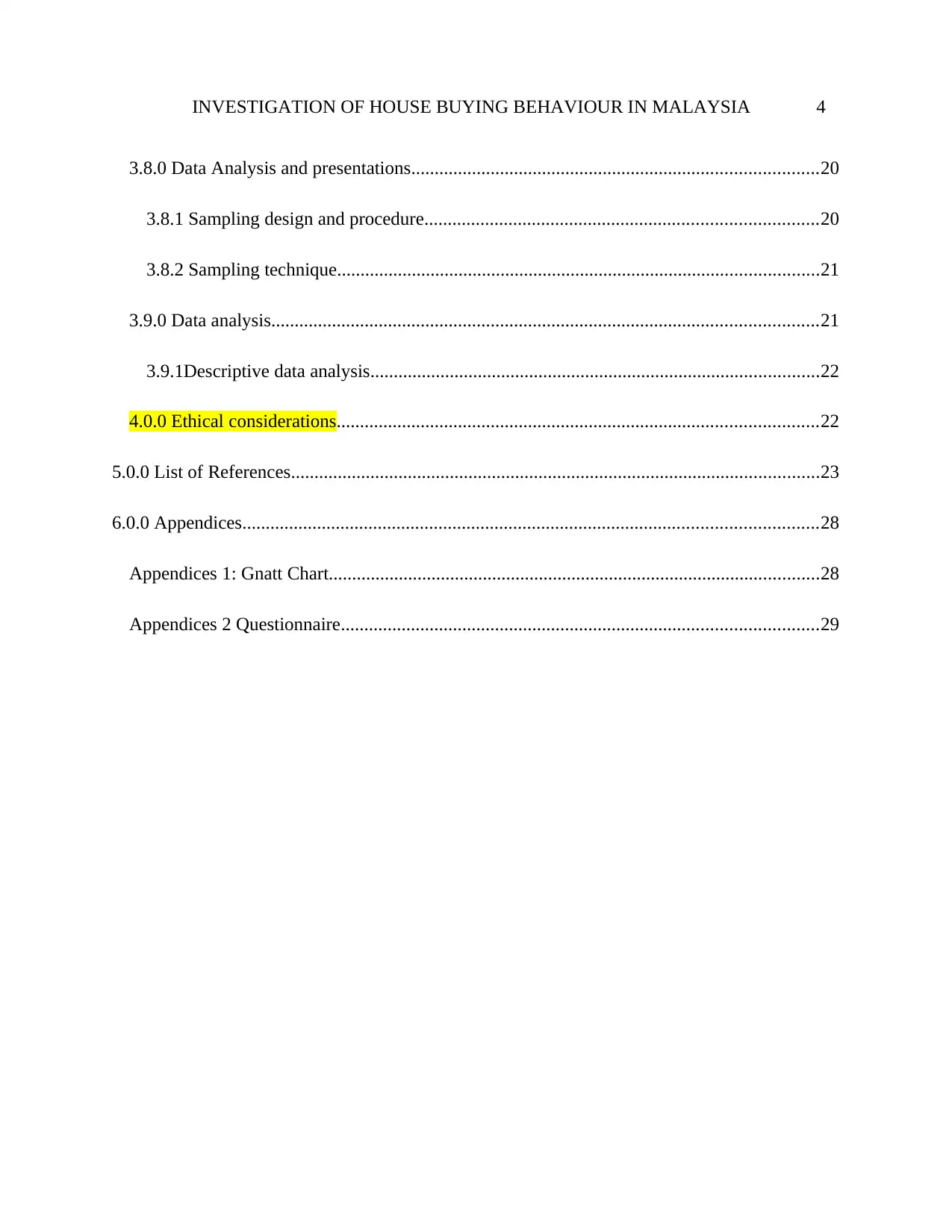
INVESTIGATION OF HOUSE BUYING BEHAVIOUR IN MALAYSIA 4
3.8.0 Data Analysis and presentations.......................................................................................20
3.8.1 Sampling design and procedure....................................................................................20
3.8.2 Sampling technique.......................................................................................................21
3.9.0 Data analysis.....................................................................................................................21
3.9.1Descriptive data analysis................................................................................................22
4.0.0 Ethical considerations.......................................................................................................22
5.0.0 List of References.................................................................................................................23
6.0.0 Appendices...........................................................................................................................28
Appendices 1: Gnatt Chart.........................................................................................................28
Appendices 2 Questionnaire......................................................................................................29
3.8.0 Data Analysis and presentations.......................................................................................20
3.8.1 Sampling design and procedure....................................................................................20
3.8.2 Sampling technique.......................................................................................................21
3.9.0 Data analysis.....................................................................................................................21
3.9.1Descriptive data analysis................................................................................................22
4.0.0 Ethical considerations.......................................................................................................22
5.0.0 List of References.................................................................................................................23
6.0.0 Appendices...........................................................................................................................28
Appendices 1: Gnatt Chart.........................................................................................................28
Appendices 2 Questionnaire......................................................................................................29
Paraphrase This Document
Need a fresh take? Get an instant paraphrase of this document with our AI Paraphraser
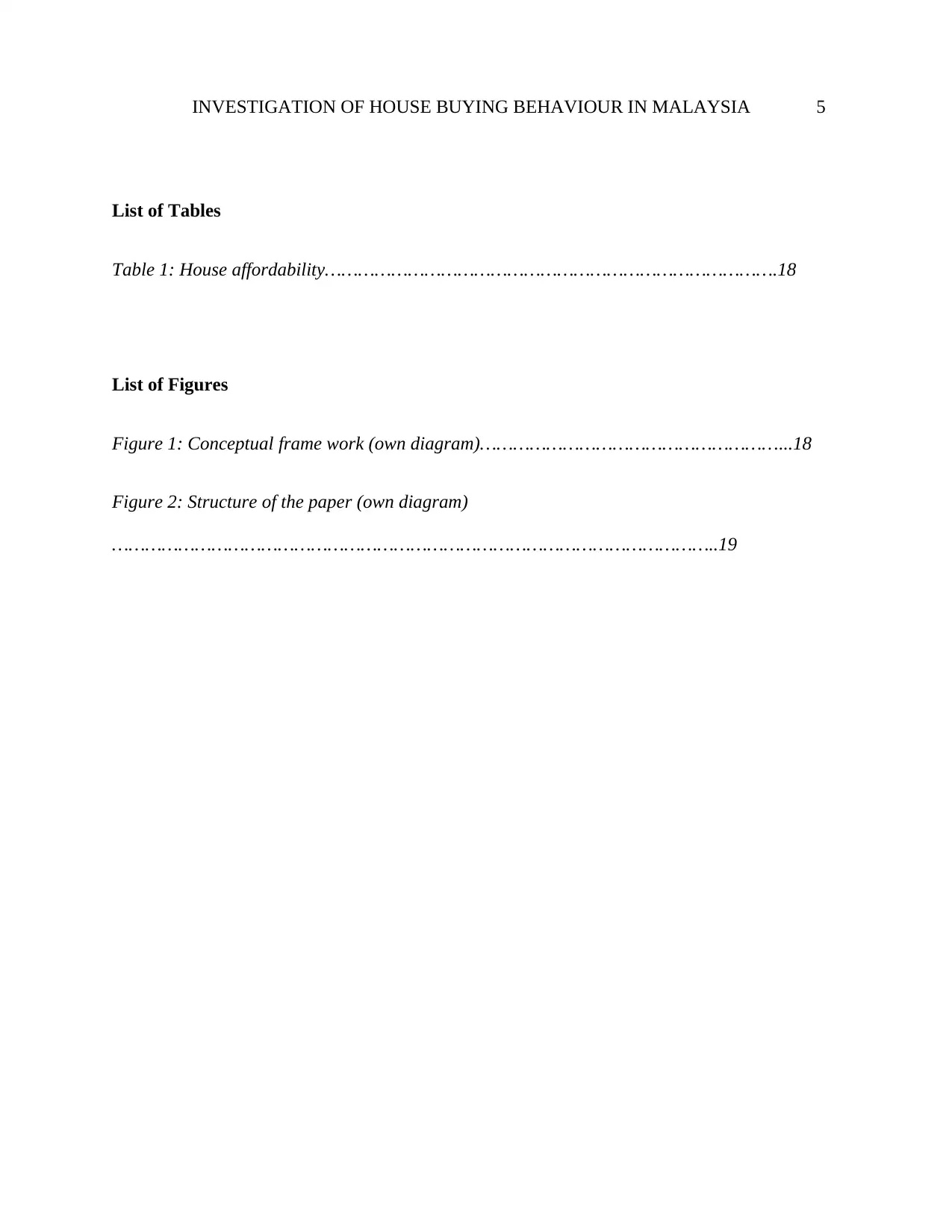
INVESTIGATION OF HOUSE BUYING BEHAVIOUR IN MALAYSIA 5
List of Tables
Table 1: House affordability……………………………………………………………………….18
List of Figures
Figure 1: Conceptual frame work (own diagram)………………………………………………...18
Figure 2: Structure of the paper (own diagram)
………………………………………………………………………………………………..19
List of Tables
Table 1: House affordability……………………………………………………………………….18
List of Figures
Figure 1: Conceptual frame work (own diagram)………………………………………………...18
Figure 2: Structure of the paper (own diagram)
………………………………………………………………………………………………..19
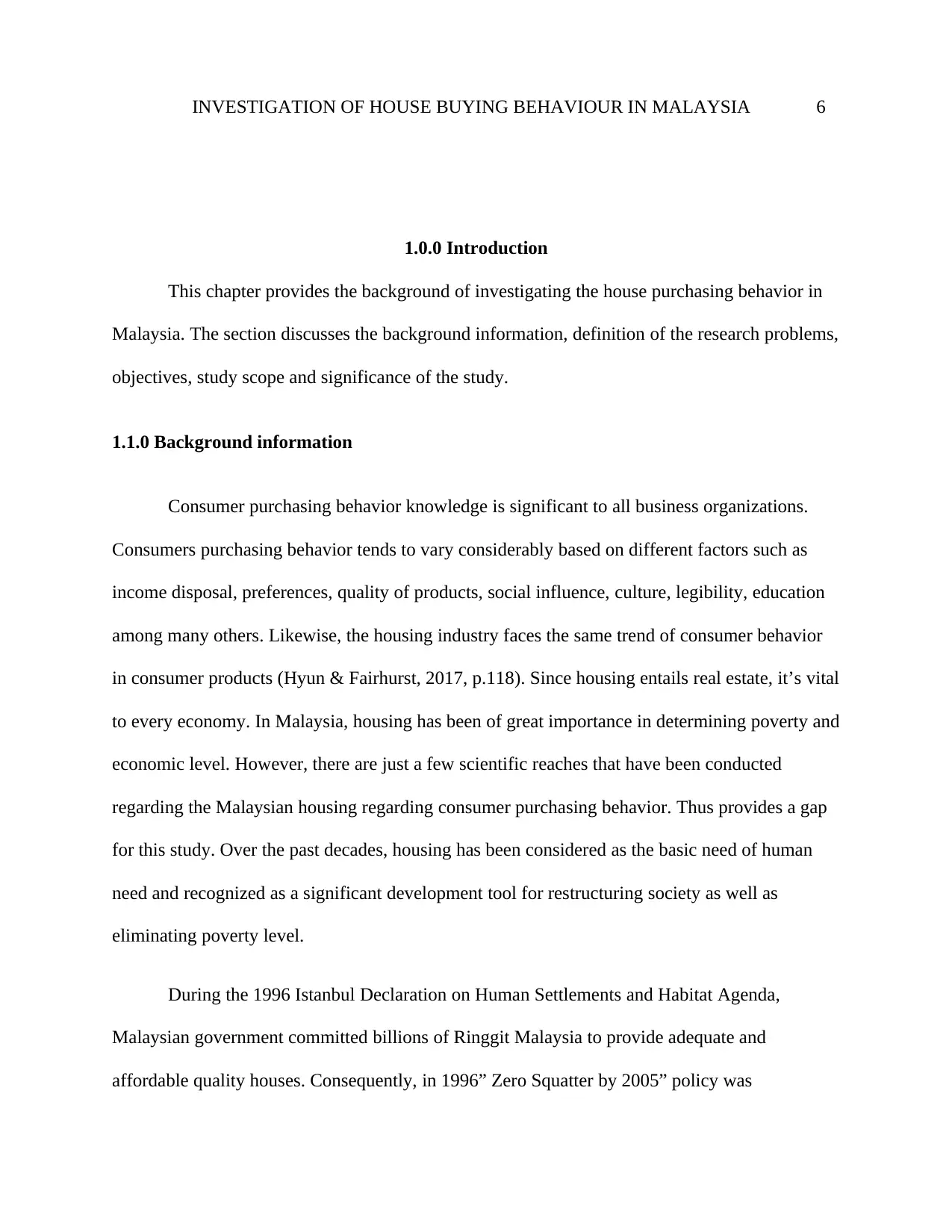
INVESTIGATION OF HOUSE BUYING BEHAVIOUR IN MALAYSIA 6
1.0.0 Introduction
This chapter provides the background of investigating the house purchasing behavior in
Malaysia. The section discusses the background information, definition of the research problems,
objectives, study scope and significance of the study.
1.1.0 Background information
Consumer purchasing behavior knowledge is significant to all business organizations.
Consumers purchasing behavior tends to vary considerably based on different factors such as
income disposal, preferences, quality of products, social influence, culture, legibility, education
among many others. Likewise, the housing industry faces the same trend of consumer behavior
in consumer products (Hyun & Fairhurst, 2017, p.118). Since housing entails real estate, it’s vital
to every economy. In Malaysia, housing has been of great importance in determining poverty and
economic level. However, there are just a few scientific reaches that have been conducted
regarding the Malaysian housing regarding consumer purchasing behavior. Thus provides a gap
for this study. Over the past decades, housing has been considered as the basic need of human
need and recognized as a significant development tool for restructuring society as well as
eliminating poverty level.
During the 1996 Istanbul Declaration on Human Settlements and Habitat Agenda,
Malaysian government committed billions of Ringgit Malaysia to provide adequate and
affordable quality houses. Consequently, in 1996” Zero Squatter by 2005” policy was
1.0.0 Introduction
This chapter provides the background of investigating the house purchasing behavior in
Malaysia. The section discusses the background information, definition of the research problems,
objectives, study scope and significance of the study.
1.1.0 Background information
Consumer purchasing behavior knowledge is significant to all business organizations.
Consumers purchasing behavior tends to vary considerably based on different factors such as
income disposal, preferences, quality of products, social influence, culture, legibility, education
among many others. Likewise, the housing industry faces the same trend of consumer behavior
in consumer products (Hyun & Fairhurst, 2017, p.118). Since housing entails real estate, it’s vital
to every economy. In Malaysia, housing has been of great importance in determining poverty and
economic level. However, there are just a few scientific reaches that have been conducted
regarding the Malaysian housing regarding consumer purchasing behavior. Thus provides a gap
for this study. Over the past decades, housing has been considered as the basic need of human
need and recognized as a significant development tool for restructuring society as well as
eliminating poverty level.
During the 1996 Istanbul Declaration on Human Settlements and Habitat Agenda,
Malaysian government committed billions of Ringgit Malaysia to provide adequate and
affordable quality houses. Consequently, in 1996” Zero Squatter by 2005” policy was
⊘ This is a preview!⊘
Do you want full access?
Subscribe today to unlock all pages.

Trusted by 1+ million students worldwide
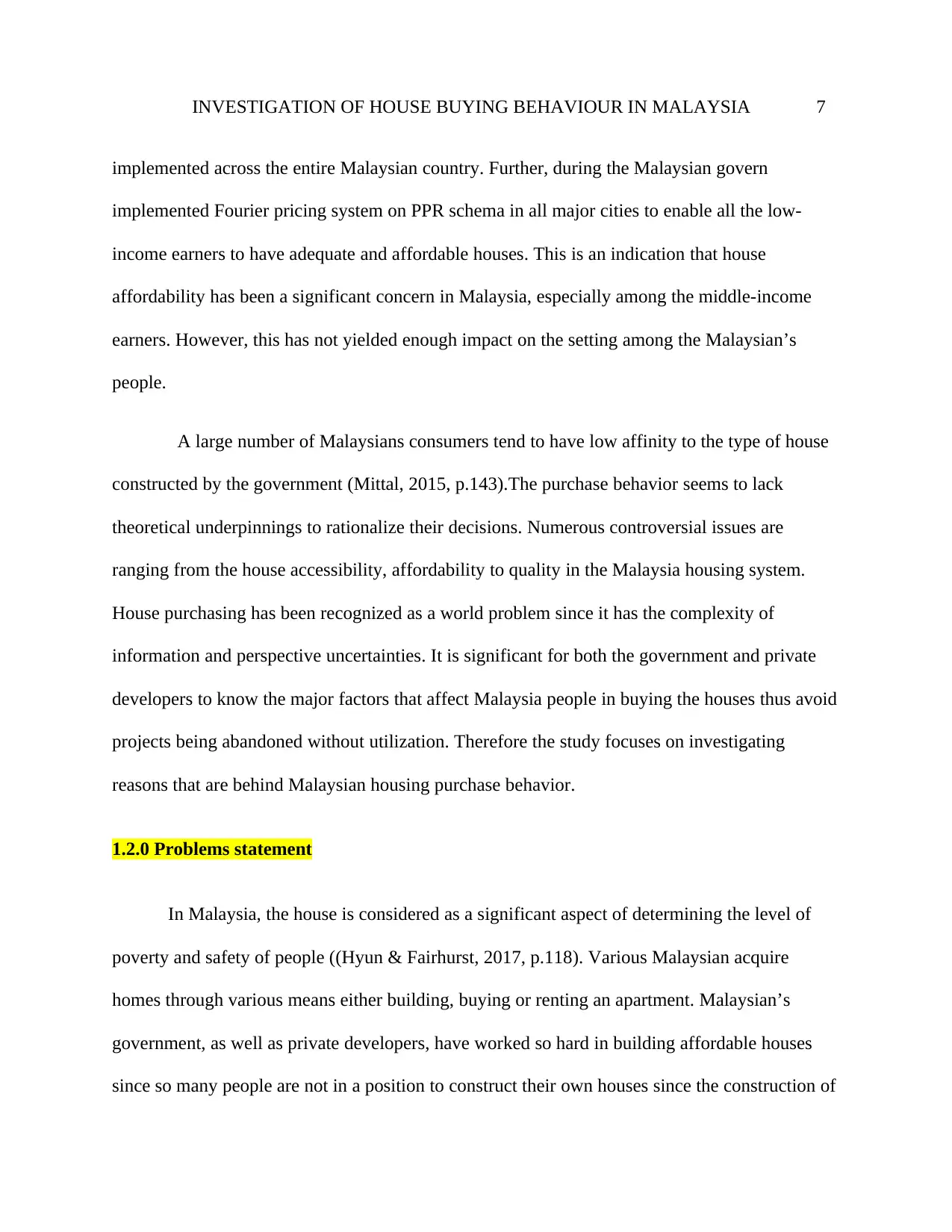
INVESTIGATION OF HOUSE BUYING BEHAVIOUR IN MALAYSIA 7
implemented across the entire Malaysian country. Further, during the Malaysian govern
implemented Fourier pricing system on PPR schema in all major cities to enable all the low-
income earners to have adequate and affordable houses. This is an indication that house
affordability has been a significant concern in Malaysia, especially among the middle-income
earners. However, this has not yielded enough impact on the setting among the Malaysian’s
people.
A large number of Malaysians consumers tend to have low affinity to the type of house
constructed by the government (Mittal, 2015, p.143).The purchase behavior seems to lack
theoretical underpinnings to rationalize their decisions. Numerous controversial issues are
ranging from the house accessibility, affordability to quality in the Malaysia housing system.
House purchasing has been recognized as a world problem since it has the complexity of
information and perspective uncertainties. It is significant for both the government and private
developers to know the major factors that affect Malaysia people in buying the houses thus avoid
projects being abandoned without utilization. Therefore the study focuses on investigating
reasons that are behind Malaysian housing purchase behavior.
1.2.0 Problems statement
In Malaysia, the house is considered as a significant aspect of determining the level of
poverty and safety of people ((Hyun & Fairhurst, 2017, p.118). Various Malaysian acquire
homes through various means either building, buying or renting an apartment. Malaysian’s
government, as well as private developers, have worked so hard in building affordable houses
since so many people are not in a position to construct their own houses since the construction of
implemented across the entire Malaysian country. Further, during the Malaysian govern
implemented Fourier pricing system on PPR schema in all major cities to enable all the low-
income earners to have adequate and affordable houses. This is an indication that house
affordability has been a significant concern in Malaysia, especially among the middle-income
earners. However, this has not yielded enough impact on the setting among the Malaysian’s
people.
A large number of Malaysians consumers tend to have low affinity to the type of house
constructed by the government (Mittal, 2015, p.143).The purchase behavior seems to lack
theoretical underpinnings to rationalize their decisions. Numerous controversial issues are
ranging from the house accessibility, affordability to quality in the Malaysia housing system.
House purchasing has been recognized as a world problem since it has the complexity of
information and perspective uncertainties. It is significant for both the government and private
developers to know the major factors that affect Malaysia people in buying the houses thus avoid
projects being abandoned without utilization. Therefore the study focuses on investigating
reasons that are behind Malaysian housing purchase behavior.
1.2.0 Problems statement
In Malaysia, the house is considered as a significant aspect of determining the level of
poverty and safety of people ((Hyun & Fairhurst, 2017, p.118). Various Malaysian acquire
homes through various means either building, buying or renting an apartment. Malaysian’s
government, as well as private developers, have worked so hard in building affordable houses
since so many people are not in a position to construct their own houses since the construction of
Paraphrase This Document
Need a fresh take? Get an instant paraphrase of this document with our AI Paraphraser
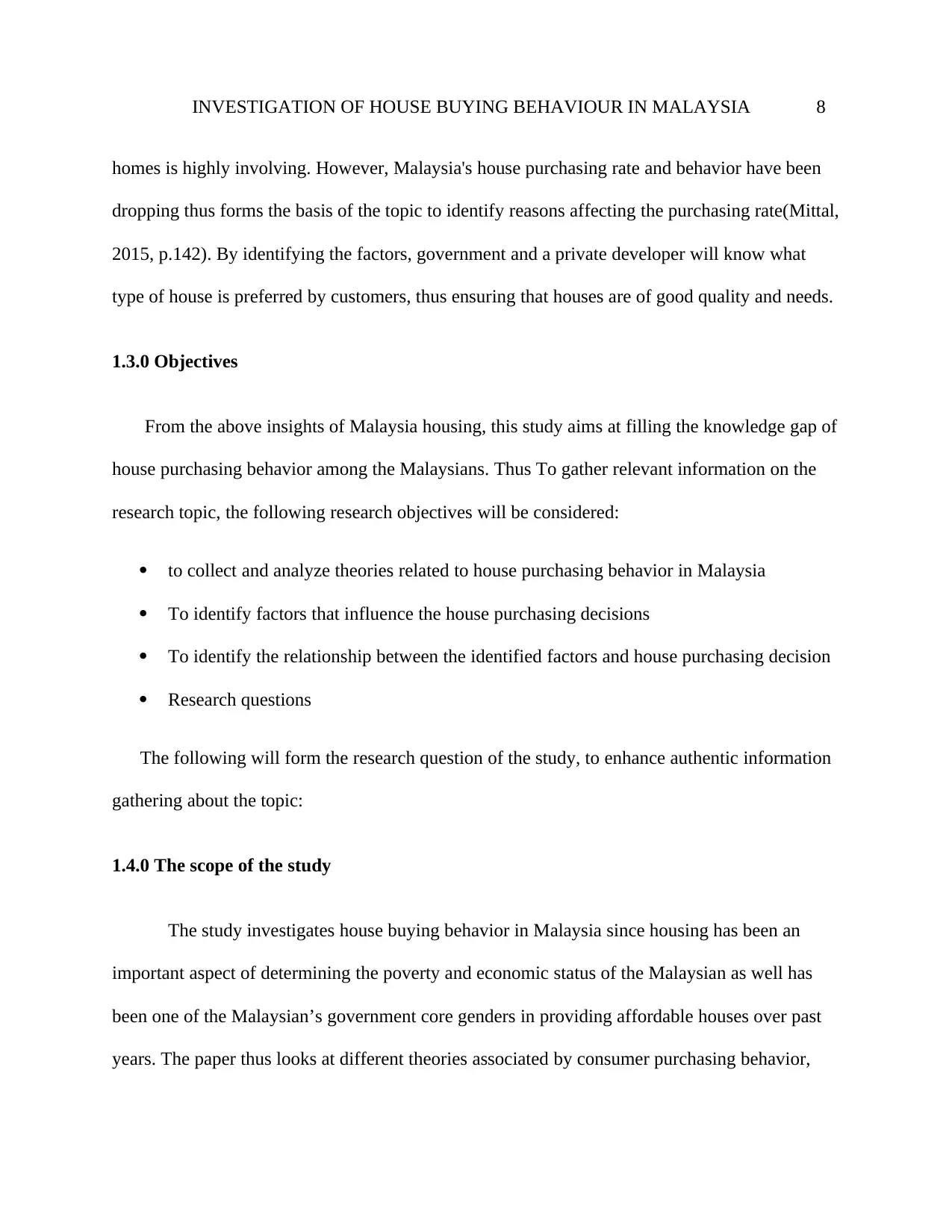
INVESTIGATION OF HOUSE BUYING BEHAVIOUR IN MALAYSIA 8
homes is highly involving. However, Malaysia's house purchasing rate and behavior have been
dropping thus forms the basis of the topic to identify reasons affecting the purchasing rate(Mittal,
2015, p.142). By identifying the factors, government and a private developer will know what
type of house is preferred by customers, thus ensuring that houses are of good quality and needs.
1.3.0 Objectives
From the above insights of Malaysia housing, this study aims at filling the knowledge gap of
house purchasing behavior among the Malaysians. Thus To gather relevant information on the
research topic, the following research objectives will be considered:
to collect and analyze theories related to house purchasing behavior in Malaysia
To identify factors that influence the house purchasing decisions
To identify the relationship between the identified factors and house purchasing decision
Research questions
The following will form the research question of the study, to enhance authentic information
gathering about the topic:
1.4.0 The scope of the study
The study investigates house buying behavior in Malaysia since housing has been an
important aspect of determining the poverty and economic status of the Malaysian as well has
been one of the Malaysian’s government core genders in providing affordable houses over past
years. The paper thus looks at different theories associated by consumer purchasing behavior,
homes is highly involving. However, Malaysia's house purchasing rate and behavior have been
dropping thus forms the basis of the topic to identify reasons affecting the purchasing rate(Mittal,
2015, p.142). By identifying the factors, government and a private developer will know what
type of house is preferred by customers, thus ensuring that houses are of good quality and needs.
1.3.0 Objectives
From the above insights of Malaysia housing, this study aims at filling the knowledge gap of
house purchasing behavior among the Malaysians. Thus To gather relevant information on the
research topic, the following research objectives will be considered:
to collect and analyze theories related to house purchasing behavior in Malaysia
To identify factors that influence the house purchasing decisions
To identify the relationship between the identified factors and house purchasing decision
Research questions
The following will form the research question of the study, to enhance authentic information
gathering about the topic:
1.4.0 The scope of the study
The study investigates house buying behavior in Malaysia since housing has been an
important aspect of determining the poverty and economic status of the Malaysian as well has
been one of the Malaysian’s government core genders in providing affordable houses over past
years. The paper thus looks at different theories associated by consumer purchasing behavior,
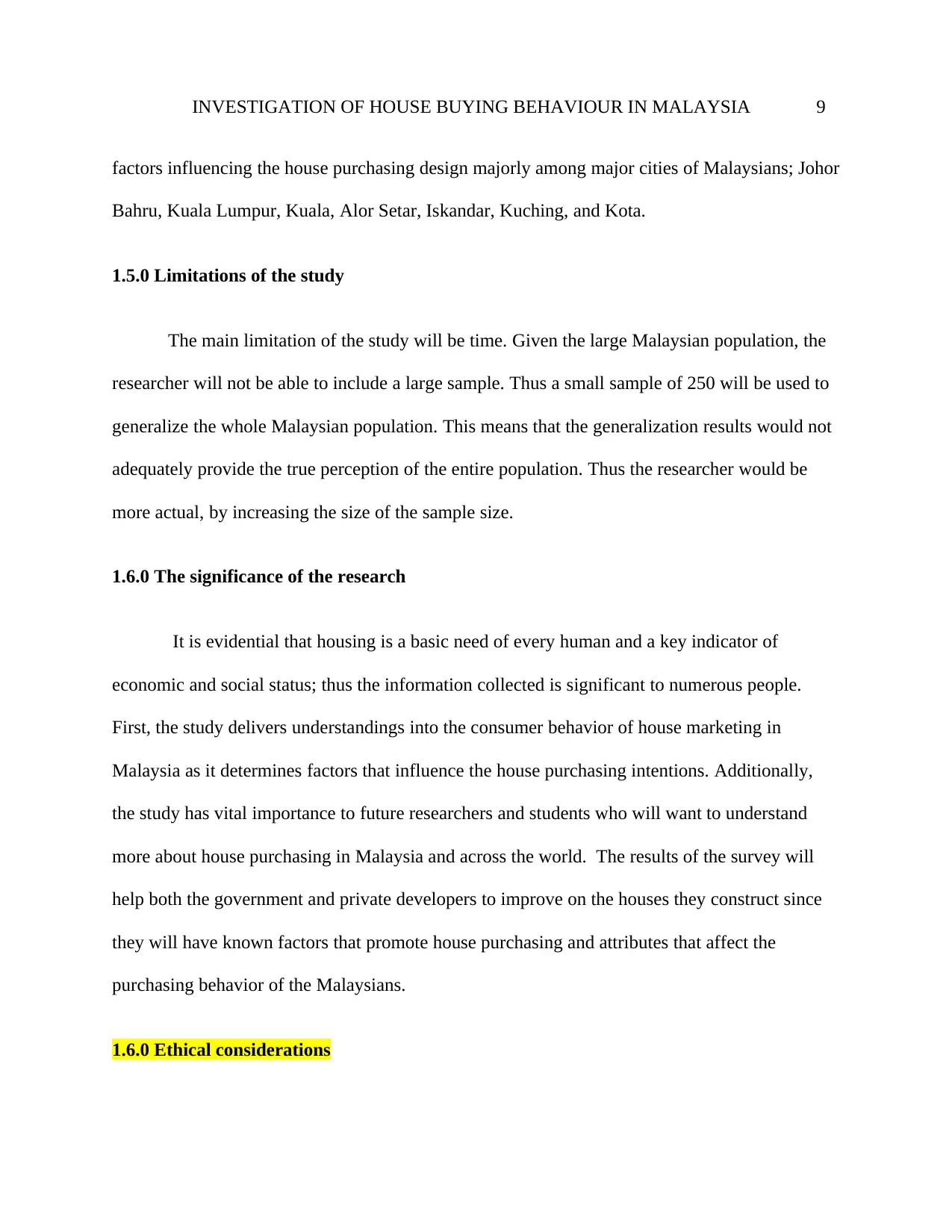
INVESTIGATION OF HOUSE BUYING BEHAVIOUR IN MALAYSIA 9
factors influencing the house purchasing design majorly among major cities of Malaysians; Johor
Bahru, Kuala Lumpur, Kuala, Alor Setar, Iskandar, Kuching, and Kota.
1.5.0 Limitations of the study
The main limitation of the study will be time. Given the large Malaysian population, the
researcher will not be able to include a large sample. Thus a small sample of 250 will be used to
generalize the whole Malaysian population. This means that the generalization results would not
adequately provide the true perception of the entire population. Thus the researcher would be
more actual, by increasing the size of the sample size.
1.6.0 The significance of the research
It is evidential that housing is a basic need of every human and a key indicator of
economic and social status; thus the information collected is significant to numerous people.
First, the study delivers understandings into the consumer behavior of house marketing in
Malaysia as it determines factors that influence the house purchasing intentions. Additionally,
the study has vital importance to future researchers and students who will want to understand
more about house purchasing in Malaysia and across the world. The results of the survey will
help both the government and private developers to improve on the houses they construct since
they will have known factors that promote house purchasing and attributes that affect the
purchasing behavior of the Malaysians.
1.6.0 Ethical considerations
factors influencing the house purchasing design majorly among major cities of Malaysians; Johor
Bahru, Kuala Lumpur, Kuala, Alor Setar, Iskandar, Kuching, and Kota.
1.5.0 Limitations of the study
The main limitation of the study will be time. Given the large Malaysian population, the
researcher will not be able to include a large sample. Thus a small sample of 250 will be used to
generalize the whole Malaysian population. This means that the generalization results would not
adequately provide the true perception of the entire population. Thus the researcher would be
more actual, by increasing the size of the sample size.
1.6.0 The significance of the research
It is evidential that housing is a basic need of every human and a key indicator of
economic and social status; thus the information collected is significant to numerous people.
First, the study delivers understandings into the consumer behavior of house marketing in
Malaysia as it determines factors that influence the house purchasing intentions. Additionally,
the study has vital importance to future researchers and students who will want to understand
more about house purchasing in Malaysia and across the world. The results of the survey will
help both the government and private developers to improve on the houses they construct since
they will have known factors that promote house purchasing and attributes that affect the
purchasing behavior of the Malaysians.
1.6.0 Ethical considerations
⊘ This is a preview!⊘
Do you want full access?
Subscribe today to unlock all pages.

Trusted by 1+ million students worldwide
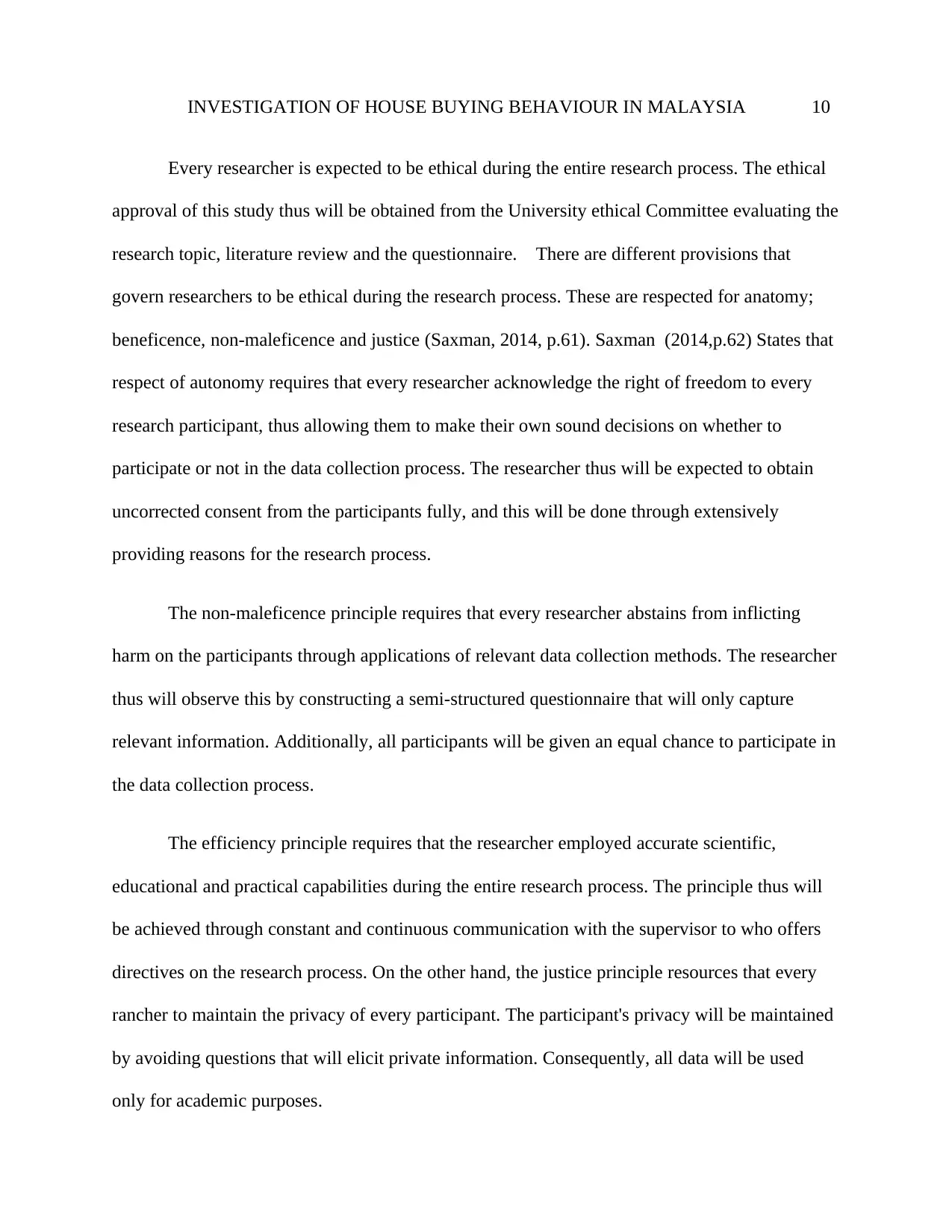
INVESTIGATION OF HOUSE BUYING BEHAVIOUR IN MALAYSIA 10
Every researcher is expected to be ethical during the entire research process. The ethical
approval of this study thus will be obtained from the University ethical Committee evaluating the
research topic, literature review and the questionnaire. There are different provisions that
govern researchers to be ethical during the research process. These are respected for anatomy;
beneficence, non-maleficence and justice (Saxman, 2014, p.61). Saxman (2014,p.62) States that
respect of autonomy requires that every researcher acknowledge the right of freedom to every
research participant, thus allowing them to make their own sound decisions on whether to
participate or not in the data collection process. The researcher thus will be expected to obtain
uncorrected consent from the participants fully, and this will be done through extensively
providing reasons for the research process.
The non-maleficence principle requires that every researcher abstains from inflicting
harm on the participants through applications of relevant data collection methods. The researcher
thus will observe this by constructing a semi-structured questionnaire that will only capture
relevant information. Additionally, all participants will be given an equal chance to participate in
the data collection process.
The efficiency principle requires that the researcher employed accurate scientific,
educational and practical capabilities during the entire research process. The principle thus will
be achieved through constant and continuous communication with the supervisor to who offers
directives on the research process. On the other hand, the justice principle resources that every
rancher to maintain the privacy of every participant. The participant's privacy will be maintained
by avoiding questions that will elicit private information. Consequently, all data will be used
only for academic purposes.
Every researcher is expected to be ethical during the entire research process. The ethical
approval of this study thus will be obtained from the University ethical Committee evaluating the
research topic, literature review and the questionnaire. There are different provisions that
govern researchers to be ethical during the research process. These are respected for anatomy;
beneficence, non-maleficence and justice (Saxman, 2014, p.61). Saxman (2014,p.62) States that
respect of autonomy requires that every researcher acknowledge the right of freedom to every
research participant, thus allowing them to make their own sound decisions on whether to
participate or not in the data collection process. The researcher thus will be expected to obtain
uncorrected consent from the participants fully, and this will be done through extensively
providing reasons for the research process.
The non-maleficence principle requires that every researcher abstains from inflicting
harm on the participants through applications of relevant data collection methods. The researcher
thus will observe this by constructing a semi-structured questionnaire that will only capture
relevant information. Additionally, all participants will be given an equal chance to participate in
the data collection process.
The efficiency principle requires that the researcher employed accurate scientific,
educational and practical capabilities during the entire research process. The principle thus will
be achieved through constant and continuous communication with the supervisor to who offers
directives on the research process. On the other hand, the justice principle resources that every
rancher to maintain the privacy of every participant. The participant's privacy will be maintained
by avoiding questions that will elicit private information. Consequently, all data will be used
only for academic purposes.
Paraphrase This Document
Need a fresh take? Get an instant paraphrase of this document with our AI Paraphraser
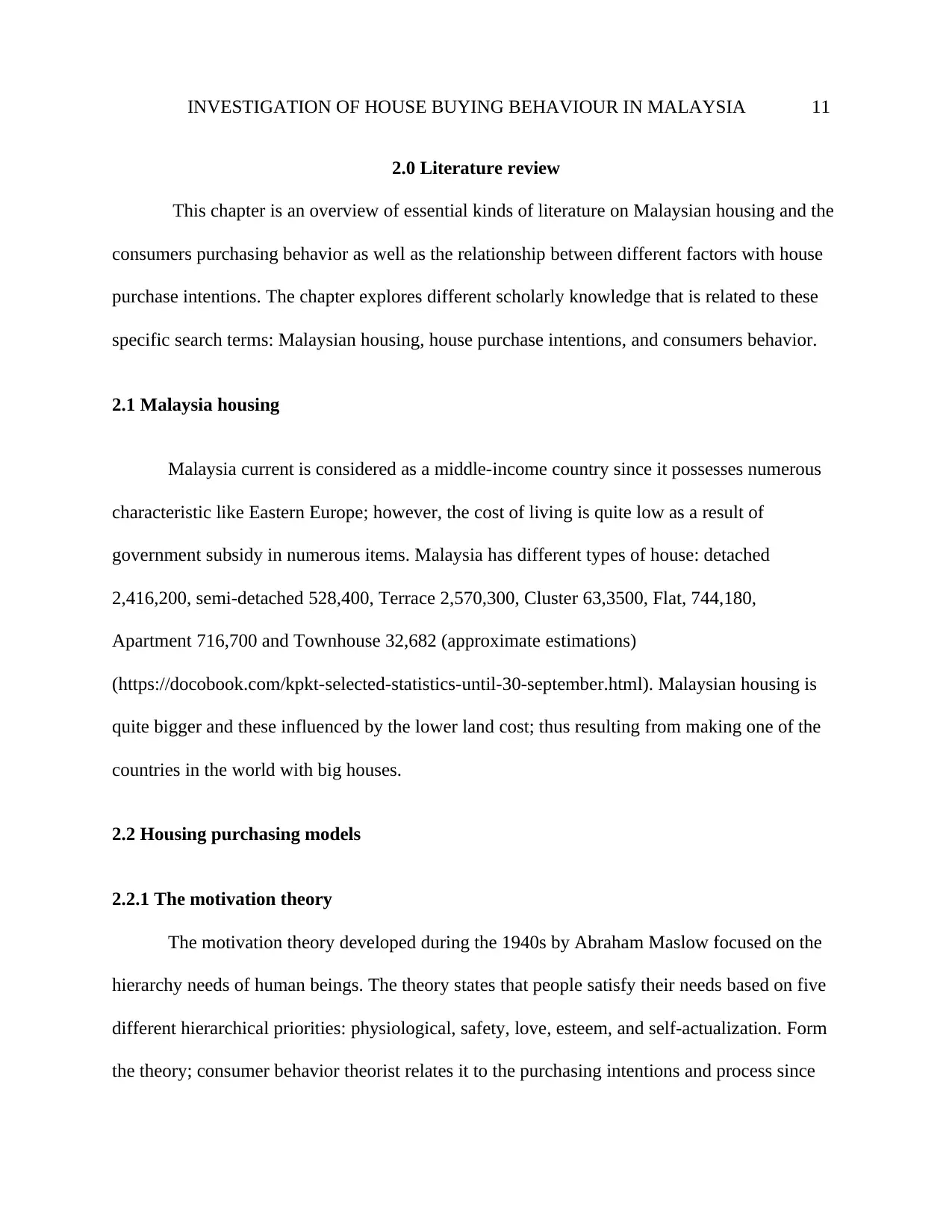
INVESTIGATION OF HOUSE BUYING BEHAVIOUR IN MALAYSIA 11
2.0 Literature review
This chapter is an overview of essential kinds of literature on Malaysian housing and the
consumers purchasing behavior as well as the relationship between different factors with house
purchase intentions. The chapter explores different scholarly knowledge that is related to these
specific search terms: Malaysian housing, house purchase intentions, and consumers behavior.
2.1 Malaysia housing
Malaysia current is considered as a middle-income country since it possesses numerous
characteristic like Eastern Europe; however, the cost of living is quite low as a result of
government subsidy in numerous items. Malaysia has different types of house: detached
2,416,200, semi-detached 528,400, Terrace 2,570,300, Cluster 63,3500, Flat, 744,180,
Apartment 716,700 and Townhouse 32,682 (approximate estimations)
(https://docobook.com/kpkt-selected-statistics-until-30-september.html). Malaysian housing is
quite bigger and these influenced by the lower land cost; thus resulting from making one of the
countries in the world with big houses.
2.2 Housing purchasing models
2.2.1 The motivation theory
The motivation theory developed during the 1940s by Abraham Maslow focused on the
hierarchy needs of human beings. The theory states that people satisfy their needs based on five
different hierarchical priorities: physiological, safety, love, esteem, and self-actualization. Form
the theory; consumer behavior theorist relates it to the purchasing intentions and process since
2.0 Literature review
This chapter is an overview of essential kinds of literature on Malaysian housing and the
consumers purchasing behavior as well as the relationship between different factors with house
purchase intentions. The chapter explores different scholarly knowledge that is related to these
specific search terms: Malaysian housing, house purchase intentions, and consumers behavior.
2.1 Malaysia housing
Malaysia current is considered as a middle-income country since it possesses numerous
characteristic like Eastern Europe; however, the cost of living is quite low as a result of
government subsidy in numerous items. Malaysia has different types of house: detached
2,416,200, semi-detached 528,400, Terrace 2,570,300, Cluster 63,3500, Flat, 744,180,
Apartment 716,700 and Townhouse 32,682 (approximate estimations)
(https://docobook.com/kpkt-selected-statistics-until-30-september.html). Malaysian housing is
quite bigger and these influenced by the lower land cost; thus resulting from making one of the
countries in the world with big houses.
2.2 Housing purchasing models
2.2.1 The motivation theory
The motivation theory developed during the 1940s by Abraham Maslow focused on the
hierarchy needs of human beings. The theory states that people satisfy their needs based on five
different hierarchical priorities: physiological, safety, love, esteem, and self-actualization. Form
the theory; consumer behavior theorist relates it to the purchasing intentions and process since
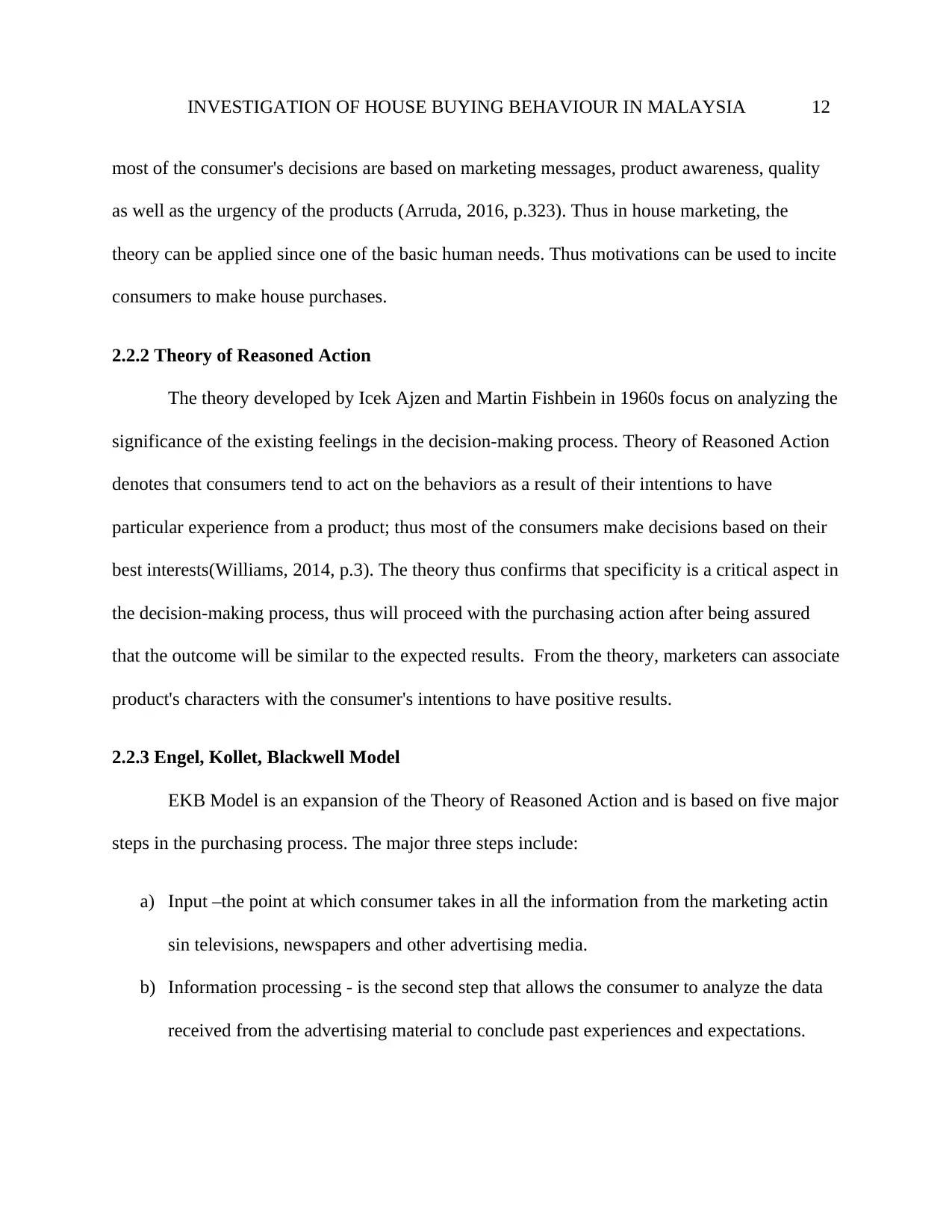
INVESTIGATION OF HOUSE BUYING BEHAVIOUR IN MALAYSIA 12
most of the consumer's decisions are based on marketing messages, product awareness, quality
as well as the urgency of the products (Arruda, 2016, p.323). Thus in house marketing, the
theory can be applied since one of the basic human needs. Thus motivations can be used to incite
consumers to make house purchases.
2.2.2 Theory of Reasoned Action
The theory developed by Icek Ajzen and Martin Fishbein in 1960s focus on analyzing the
significance of the existing feelings in the decision-making process. Theory of Reasoned Action
denotes that consumers tend to act on the behaviors as a result of their intentions to have
particular experience from a product; thus most of the consumers make decisions based on their
best interests(Williams, 2014, p.3). The theory thus confirms that specificity is a critical aspect in
the decision-making process, thus will proceed with the purchasing action after being assured
that the outcome will be similar to the expected results. From the theory, marketers can associate
product's characters with the consumer's intentions to have positive results.
2.2.3 Engel, Kollet, Blackwell Model
EKB Model is an expansion of the Theory of Reasoned Action and is based on five major
steps in the purchasing process. The major three steps include:
a) Input –the point at which consumer takes in all the information from the marketing actin
sin televisions, newspapers and other advertising media.
b) Information processing - is the second step that allows the consumer to analyze the data
received from the advertising material to conclude past experiences and expectations.
most of the consumer's decisions are based on marketing messages, product awareness, quality
as well as the urgency of the products (Arruda, 2016, p.323). Thus in house marketing, the
theory can be applied since one of the basic human needs. Thus motivations can be used to incite
consumers to make house purchases.
2.2.2 Theory of Reasoned Action
The theory developed by Icek Ajzen and Martin Fishbein in 1960s focus on analyzing the
significance of the existing feelings in the decision-making process. Theory of Reasoned Action
denotes that consumers tend to act on the behaviors as a result of their intentions to have
particular experience from a product; thus most of the consumers make decisions based on their
best interests(Williams, 2014, p.3). The theory thus confirms that specificity is a critical aspect in
the decision-making process, thus will proceed with the purchasing action after being assured
that the outcome will be similar to the expected results. From the theory, marketers can associate
product's characters with the consumer's intentions to have positive results.
2.2.3 Engel, Kollet, Blackwell Model
EKB Model is an expansion of the Theory of Reasoned Action and is based on five major
steps in the purchasing process. The major three steps include:
a) Input –the point at which consumer takes in all the information from the marketing actin
sin televisions, newspapers and other advertising media.
b) Information processing - is the second step that allows the consumer to analyze the data
received from the advertising material to conclude past experiences and expectations.
⊘ This is a preview!⊘
Do you want full access?
Subscribe today to unlock all pages.

Trusted by 1+ million students worldwide
1 out of 36
Related Documents
Your All-in-One AI-Powered Toolkit for Academic Success.
+13062052269
info@desklib.com
Available 24*7 on WhatsApp / Email
![[object Object]](/_next/static/media/star-bottom.7253800d.svg)
Unlock your academic potential
Copyright © 2020–2025 A2Z Services. All Rights Reserved. Developed and managed by ZUCOL.





